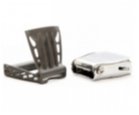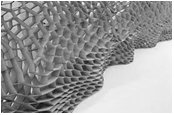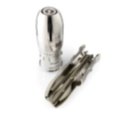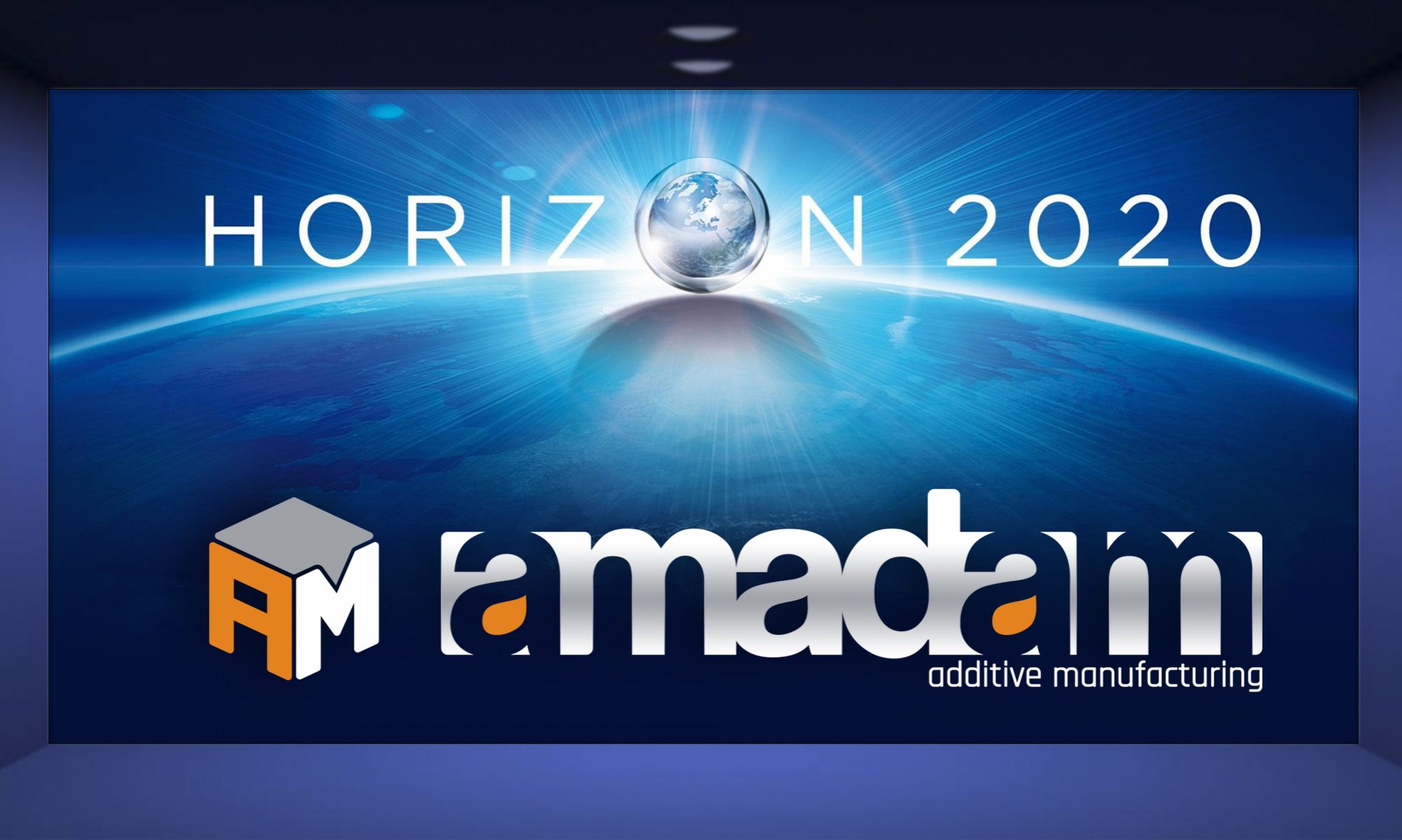Introduction
The project A_MADAM was developed in the spring of 2016, and this page presents the idea behind the project, that was based on the problems and knowledge of that moment-
During the current decade, the focus of the rapidly developing area of additive manufacturing (AM) is moving from rapid prototyping (RP) applications to rapid manufacturing (RM) of high-performance parts/products. Since AM is suitable for manufacturing of complex parts, it opens up new possibilities for innovative design. Shape optimization based on AM comprises nowadays areas of design such as lightweight design (e.g. lattice and honeycomb structures, net-shaped parts), design for advanced functionality (e.g. tools with conformal cooling channels) and design for optimized topology (e.g. biomimetic structures), with some examples presented in the following figures:
 |
 |
 |
Lightweight products (left), biomimetic structures (centre) and advanced tools (right) manufactured by AM technologies
As technology with great possibilities and high production costs, AM has intriguing potential for revolutionizing of industrial sectors with high added value, characteristic for EU industry, as it is the case with automotive and aerospace industry, medicine, tool manufacturing and consumer goods production. Since the product unit costs are insensitive to production scale, AM technologies are suitable for sophisticated products based on knowledge and creativity of skilled designers, opposite to the conventional technologies, which favour low prices of mass production. The AM technologies require skilled and innovative professionals in each step of product lifecycle, opening possibilities for creation of new services and development of new business models. A great example is success of Belgian company “Materialize”, which applied innovative technology and innovative, web-based, business model to become world leader in delivery of 3D printing services. For the presented reasons, AM is recognized by EU forums as key technology for creation of sustainable high-value European-based employment that addresses societal issues and supports environmental stability.
General problem
The application of AM technologies for manufacturing of high-performance products grows, and even the leading world companies will need highly efficient suppliers as demand increases. However, the supply side, especially from European SMEs, is still weak, requiring systematic analysis and number of measures as response. One of serious efforts to understand the present AM trends in Europe was the H2020 project “Industrial and regional valorisation of FoF Additive Manufacturing Projects” (FoFAM), which aims to cluster developments on AM technologies and associated regimes and to develop a strategy to ensure AM industrial deployment. One of the conclusions of the project activities (FoFAM, 2016a) is that the wider application of AM is hindered by a gap between knowledge and usage of the technology. AM is relatively new, and vast majority of managers and engineers, used to limitations of conventional manufacturing technologies do not know how to use the advantages of AM to improve performances of present and new products. In order to achieve the expected progress, the AM technology has to be „put in the hands“ of industrial and mechanical designers, but also managers, students and even users. FoFAM reports (FoFAM, 2016b) that „training and skills for AM are a concern in at least half the EU regions, with the need to develop industrial training methods that allow adaptability of the workforce and faster knowledge transfer“. The conclusion that FoFAM derives is that „creating the demand for innovative skills and developing novel curricula are viewed as critical elements in AM strategy“ (FoFAM, 2016b).
Specific problem
The clear demand for development of novel curricula and training methods, however, meets an obstacle in the fact that the knowledge of the AM technology is still mainly expressed in the scientific form, suitable for researchers. It means that the knowledge about the AM technology is predominantly present in the form of analytic formulae, tables and figures published in scientific journals, proceedings of scientific conferences and books written by, and for the AM technology experts. On the other hand, the problems of design for AM are met by product designers, who are not experts in AM. The product designers usually solve two classes of problems, which are sometimes referred as industrial design and mechanical design. The industrial design problems mainly consider aesthetic aspect, and only basic functional characteristics, of a product. Mechanical design, on the other hand, deals with numerous exploitation characteristics of the product, such as stability of dimensions, various aspects of mechanical strength and environmental impacts. Due to complexity of the demanding expertise, mechanical designers use design rules developed by experts in technology, materials science, experimental mechanics, and physics. The rules enable calculations of behaviour of the designed product with the aim to comply with relevant standards, norms and regulations. Therefore, before development of novel curricula and training methods, it is necessary make and additional research effort to “translate” the scientific knowledge into the rules of design of products manufactured by AM technologies.
The process of definition of rules for design of products by AM develops together with process of development of AM technologies. The basic rules of design that consider geometry the products manufactured by AM are mainly known as they are presented in both research papers (Kranz, 2015) and rulebooks for engineers (Geometric, 2013; EOS website, 2015a; ASTM, 2015). Static mechanical properties of the AM products were also studied, and the results transformed in material data sheets provided by manufacturers (EOS website, 2015b, 2015c). Nevertheless, due to the layered structure of the objects manufactured by AM, homogeneity and isotropy of the AM products can be serious issues, especially when designing structural components (Berti, 2010; Cooke 2011), so that further research in field of rules of design for optimal static mechanical properties of AM products are still welcome.
On the other hand, the research of dynamic mechanical properties of AM products is still in the phase of growth, and the respective rules of design for optimal dynamic mechanical properties of AM products are not defined. The performed research works were mainly focused on fatigue properties and fatigue crack grow rate of titanium alloys. The results have shown that the layered structure of AM products leads to reduction of fatigue life of AM parts with respect to parts manufactured by conventional technologies (Nagano et al, 2007). The research team that realizes the A_MADAM project reported (Croccolo et al, 2016) that „the fatigue strength and, particularly, the fatigue limit are lower than the expected one, based on its static strength. The fatigue limit can be usually roughly estimated as 50% of the ultimate tensile strength of the base material for most steel materials, whereas for maraging steels, lower values, around 20–30% of the ultimate tensile strength , are reported in the literature“. Researches have shown that the fatigue strength may be improved by post-processing. Studies of fracture toughness and the fatigue crack growth rate performed by members of the A_MADAM project team (Zucchelli et al, 2016) have revealed that building direction influences fracture toughness and the fatigue crack growth rate in samples built by AM due to anisotropic distribution of residual stresses. The results were confirmed by other authors (Cain et al, 2015).
Industrial application of AM technology for RM requires systematic understanding of the dynamic mechanic behaviour of AM products. Therefore, it is necessary to carry out a research program that will start with a systematic study of influence of building conditions and post-processing to dynamic properties of AM products. In order to separate the effects of AM, the study has to include research on wide set of materials. The results of the study should then be used in the second part of the research program, which will study dynamic mechanical behaviour of real mechanical parts in various exploitation conditions.
General and specific objectives of the project
The general objective of project A_MADAM is to contribute to increase of the application of AM technologies by development of rules of design for optimal dynamic mechanical properties of AM products. The specific goal of the project is to develop and publish rules for design for optimal fatigue properties and impact resistance of products manufactured by selective laser sintering (SLS).
The project A_MADAM has focus on SLS technology for two reasons: first, the products manufactured by SLS technologies have superior mechanical properties in comparison with the other AM technologies; and second, SLS technologies enable manufacturing of products from comparatively wide set of materials, including both metals and plastics. The research program will include investigation of metal materials (maraging and stainless steel, aluminium, titanium, cobalt-chrome alloys), plastics materials (polyamide) and composite materials (glass-filled polyamide, carbon-filled polyamide and aluminium-filled polyamide).
The intention of the A_MADAM research program is to establish, if it turns out to be possible, functional dependencies between manufacturing process features and the observed mechanical characteristics of the studied samples, which would open possibilities for optimization of both product design with respect to manufacturing process, and manufacturing process with respect to the product design. The obtained functional dependencies will represent results of scientific interest, which will be published in scientific journals and presented at scientific conferences.
However, the ultimate objective of the project is establishment of an advanced set of design rules for products made by SLS, which will be offered to engineers and designers as target group. The advanced set of rules comprises rules for fatigue resistance and impact resistance of products made by SLS, and it substantially improves the basic set of rules, which describes limitations that technology puts on geometric characteristics of products. The defined design rules will be published in an open-access public digital repository, and thus available to all mechanical and industrial designers, as well as to students, managers and other public.
The A_MADAM research program requires expertise in SLS technology, material science, experimental mechanics and characterization of spatial distribution of stress. For that reason in the consortium are included Faculty of Mechanical and Civil Engineering of University of Kragujevac – Serbia (UniKv), with expertise in SLS technology, Italian Department for Industrial Engineering of University of Bologna – Italy (UniBo), with expertise in experimental mechanics, and company “Topomatika” from Zagreb – Croatia (TOP), with expertise in optical measurement methods. The researchers from UniBo and UniKv have studied dynamic mechanical behaviour of metal and polymer test samples manufactured by SLS. One research group, under the leadership of prof. Dario Croccolo from UniBo, studied fatigue strength of samples manufactured from various steel alloys, while the research group, under the leadership of prof. Ciric-Kostic from UniKv and prof. Minak from UniBo, studied fatigue toughness of polymers.
However, the task of transforming the scientific research results into practical knowledge useful for mechanical designers requires understanding of needs and limitations of mechanical designers who use AM for RP, RM and rapid tooling (RT) applications. To meet the request, the consortium includes company “Studio Pedrini” from Bologna – Italy (SP), specialized in prototyping applications including RP, and company “Plamingo” from Gracanica – Bosnia & Herzegovina (PLA), specialized in tooling applications including RT. The key to the successful realization of the project is closing of the gap between academic and industrial sector, which may be achieved by acquiring the first-hand experience from the other sector in extensive process of knowledge exchange, implemented through series of inter-sectorial secondments.
References
- ASTM International, ASTM WK51841 “Proposed ASTM International Guide to Create Principles of Design Rules in Additive Manufacturing (3D Printing)”, http://additivemanufacturing.com/2015/11/09/proposed-astm-international-guide-to-create-principles-of-design-rules-in-additive-manufacturing-3d-printing/
- Berti, L. D’Angelo, A. Gatto, and L. Iuliano. “Mechanical characterisation of PA-Al2O3 composites obtained by selective laser sintering” Rapid Prototyping Journal, 16(2), pp.124‑129
- Cain, L. Thijs, J. Van Humbeeck, B. Van Hooreweder, R. Knutsen. “Crack propagation and fracture toughness of Ti6Al4V alloy produced by selective laser melting”. Add Man, 2015;5:68‑76
- Cooke, R.A. Tomlinson, R. Burguete, D. Johns, G. Vanard: “Anisotropy, homogeneity and ageing in an SLS polymer”. Rapid Prototyping J, 2011;17(4): pp. 269‑279
- Croccolo, D., De Agostini, M., Fini, S., Olmi, G., Vranic, A.; Ciric-Kostic, S: “Influence of the build orientation on the fatigue strength of EOS maraging steel produced by additive metal machine”, Fatigue and Fracture of Engineering Materials and Structures, Volume 39, Iss. 5, pp. 637‑647
- EOS website, “Material properties-metals”, http://www.eos.info/material-m
- EOS website, “Material properties-plastics”, http://www.eos.info/material-p
- EOS website , “Basic Design Rules for Additive Manufacturing”, http://www.eos.info/en
- FoFAM project, D3.2_”Report_on_non-technological_activities” ; http://www.fofamproject.eu/images/D3.2_Report_on_non-technological_activities_.pdf
- FoFAM project, D2.2_”Regional_capabilities”, http://www.fofamproject.eu/images/FoFAM_D2.2_Regional_capabilities.pdf
- Geometric, “Design for Additive Manufacturing”, white paper, http://geometricglobal.com/wp-content/uploads/2013/11/Geometric_Whitepaper-Additive-Manufacturing_July-2013.pdf.pdf
- Kranz, D. Herzog, and C. Emmelmann, “Design guidelines for laser additive manufacturing of lightweight structures in TiAl6V4”, Journal of Laser Applications 27, S14001 (2015)
- Nagano, T., Kawagoishi, N., Moriyama, M., Chen, Q. and Nagashima, E. ”Influence of shot peening on fatigue strength of maraging steels with different hardness”. J Soc Mater. Sci., 56, 1126‑1132. DOI:10.2472/jsms.56.1126
- Zucchelli, A.., Brugo, T., Palazzetti, R., Ciric-Kostic, S., Yan, X.T., Minak, G: “ Fracture mechanics of laser sintered cracked polyamide for a new method to induce cracks by additive manufacturing”, Polymer Testing, Volume 50, april 2016, pp. 301‑308
